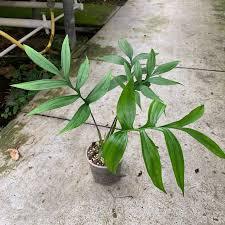The Monstera subpinnata stands out amongst its Monstera relatives with its unique, deeply divided leaves that create an almost feathery appearance. It’s a captivating, climbing beauty sure to elevate your indoor plant collection. Let’s delve into the keys to keeping this tropical gem flourishing.

The Fundamentals of Care
- Light: Bright, Filtered Sunlight Like most Monsteras, the subpinnata thrives in bright, indirect light. Mimic the dappled sunlight it would receive in its natural rainforest environment. An east-facing window is ideal. Harsh, direct sun will damage its leaves, while too little light hinders growth and its beautiful fenestrations.
- Watering: Let the Soil Be Your Guide Monstera subpinnata follows the classic “soak and dry” watering technique. Allow the top few inches of soil dry out before giving your plant a thorough watering. Be mindful of overwatering, which can lead to root problems.
- Humidity: Recreate the Rainforest As a tropical plant, the Monstera subpinnata loves humidity! Aim for humidity levels above 50%, employing strategies like a humidifier, a pebble tray filled with water, or grouping the plant with other humidity-loving friends.
- Soil: Airy and Well-Draining A loose, chunky aroid mix provides the proper drainage and aeration this plant needs. You can find pre-made mixes or create your own simple blend using ingredients like coco coir, perlite, orchid bark, and a dash of potting soil.
Encouraging Optimal Growth
- Upward and Onward: Support its Climbing Nature In its natural habitat, the Monstera subpinnata climbs trees for support. Providing a moss pole, trellis, or a plank of wood encourages healthy growth and those stunning, mature leaves with deeply split fenestrations.
- Nourishment for Growth During the active growing season (spring and summer), treat your Monstera subpinnata to a diluted, balanced liquid fertilizer approximately every other week. Use a fertilizer formulated for aroids or general foliage plants, and follow the instructions for dilution.
- Temperature: Tropical Warmth This plant prefers a cozy environment between 65-85°F. Protect it from cold drafts, especially during the colder months, which can cause stress.
Troubleshooting and FAQs
- Why Are My Leaves Turning Yellow? Yellowing leaves usually signal a watering issue – either overwatering or underwatering. Check the soil moisture and adjust your watering schedule accordingly. A lack of nutrients can also contribute, so ensure you’re fertilizing correctly.
- Why Don’t My Leaves Have Splits? Leaf fenestrations develop on larger, mature Monstera subpinnata leaves, especially as the plant climbs. Provide a support structure and ensure your plant has bright, indirect light for the best results.
- Pests and Management Like many houseplants, your Monstera subpinnata might attract pests like spider mites, scale, or mealybugs. Regularly inspect your plant and treat infestations promptly with natural remedies or insecticidal soap.
The Gift of Propagation
Sharing the Monstera subpinnata’s unique beauty is simple! Here’s how to propagate it:
- Locate a Node: Find a healthy node (a small brown bump) along the stem where a leaf or aerial root emerges.
- Cut and Propagate: Cut a stem section ensuring it includes at least one node and a leaf. Choose between water propagation (submerge the node in a jar of water) or direct soil propagation in a well-draining potting mix.
- Light and Patience: Provide bright, indirect light and let nature work its magic. Roots should appear within a few weeks.
Conclusion With mindful care, your Monstera subpinnata will reward you with stunning foliage reminiscent of delicate ferns. Imagine its gracefully cascading vines or a mature specimen climbing with its deeply fenestrated leaves – a true tropical treasure in your home!
Leave a Reply